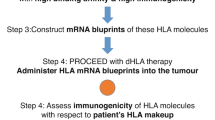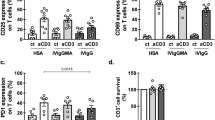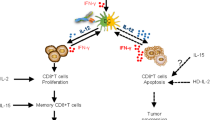Abstract
The in vivo antitumour activities of recombinant human interleukin-2 (rHIL-2) and recombinant human hybrid interferon alpha A/D (rIFN-alpha A/D) were tested in relation to adenocarcinoma 755. The tumour growth, following s.c. inoculation of tumour cells, was inhibited to a greater extent in mice treated with the combination of cytokines than in mice treated with either one alone. Pretreatment with these cytokines did not affect the tumour growth. Injection of tumour-bearing mice with a combination of these cytokines resulted in a marked increase in the total number of lymphocytes in the peritoneal cavity. Among them, Lyt-2+/L3T4- and asialo GM1+ cells were markedly enhanced by the combination of cytokines, and the frequencies of these marker cells were closely correlated with the antitumour activity. In tumour-bearing mice, the size of the thymus was decreased while that of the spleen was increased compared to non-tumour-bearing (normal) mice. Treatment with rHIL-2 caused the thymus, spleen and liver to be larger compared to untreated tumour-bearing mice, but when treated with a combination of rHIL-2 and rIFN-alpha A/D these organs were smaller than when rHIL-2 was administered alone. Thymocytes were drastically changed when mice were bearing a tumour or were treated with a cytokine. Especially immature T-cells, Lyt-2+/L3T4+, were drastically decreased in tumour-bearing mice, but were maintained following administration of rHIL-2 or rIFN-alpha A/D. When treated with rHIL-2 plus rIFN-alpha A/D, Lyt-2+/L3T4+ T-cells were decreased while Lyt-2+/L3T4- T-cells were increased. Frequency of immature T-cells, Lyt-2-/L3T4-, was not changed. On the other hand, T-cell subsets of splenocytes were markedly decreased in tumour-bearing mice compared to normal mice, but all the subsets of splenocytes were almost unchanged even when tumour-bearing mice were treated with rHIL-2 plus rIFN-alpha A/D. Thus, injection of rHIL-2 and rIFN-alpha A/D to tumour-bearing mice resulted in induction of Lyt-2+/L3T4- and asialo GM1+ cells in the peritoneal cavity, and the frequencies correlated with the observed antitumour activity in vivo in this murine model. The increase in Lyt-2+/L3T4- T-cells in the peritoneal cavity may be related to changes in the T-cells in thymus.
This is a preview of subscription content, access via your institution
Access options
Subscribe to this journal
Receive 24 print issues and online access
$259.00 per year
only $10.79 per issue
Buy this article
- Purchase on Springer Link
- Instant access to full article PDF
Prices may be subject to local taxes which are calculated during checkout
Similar content being viewed by others
Author information
Authors and Affiliations
Rights and permissions
About this article
Cite this article
Iigo, M., Nakajima, Y., Nishikata, K. et al. Effects of interleukin-2 and interferon-αA/D treatment on lymphocytes from tumour-bearing mice. Br J Cancer 59, 883–888 (1989). https://doi.org/10.1038/bjc.1989.187
Issue Date:
DOI: https://doi.org/10.1038/bjc.1989.187
This article is cited by
-
Enhanced therapeutic effects of anti-tumour agents against growth and metastasis of colon carcinoma 26 when given in combination with interferon and interleukin-2
Clinical & Experimental Metastasis (1994)
-
Chemo-adoptive immunotherapy of nude mice implanted with human colorectal carcinoma and melanoma cell lines
Cancer Immunology Immunotherapy (1992)



